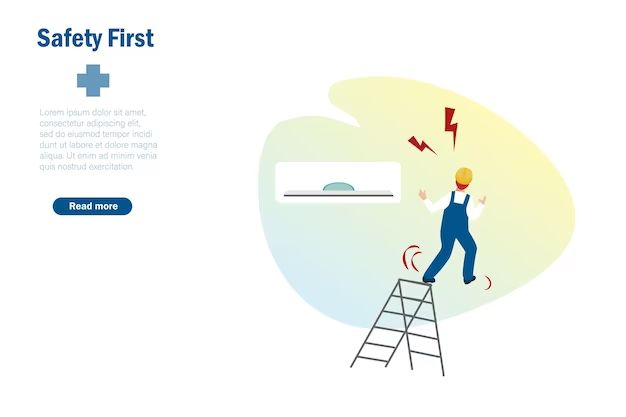When it comes to using ladders safely, choosing the right type of ladder for the job is crucial. The safest type of ladder depends on several factors, including the height you need to reach, the amount of weight the ladder needs to support, and the surface you’re placing the ladder on. Understanding the advantages and disadvantages of different ladder types can help you select the safest option.
Page Contents
Step Ladders
Step ladders are self-supporting A-frame ladders with a hinged design that allows them to fold up for easy storage and transport. They come in various sizes, typically ranging from 3 to 20 feet tall. Step ladders have a wider, more stable base than straight ladders and stand on their own without needing any additional support. This makes them a very safe choice when you need to reach heights up to 20 feet or less.
The key advantages of step ladders from a safety perspective include:
- Wider base provides more stability than straight ladders
- Can be used fully open or partially closed depending on the height needed
- Has a hinged design that allows the ladder to stand on its own
- Features a tray on top to hold paint cans or tools when working
Potential drawbacks to consider are that step ladders:
- Are not suitable for heights over 20 feet
- Can be heavy and bulkier than other ladder types
- Have a lower weight capacity than extension or straight ladders
Overall, step ladders provide a very safe and stable option for DIY, maintenance, painting, and other tasks that require you to reach up to 20 feet. Just be sure to choose the right size step ladder for the height you need and don’t exceed the weight limits.
Extension Ladders
Extension ladders are non-self-supporting portable ladders that can be extended to provide greater vertical height. They consist of two or more sections that slide together to customize the ladder length as needed. Extension ladders are available in lengths from 16 feet up to 60 feet when fully extended.
Here are some of the key advantages of extension ladders:
- Can safely reach heights up to 60 feet
- Adjustable length – good for a wide range of heights
- Lightweight and easy to transport
- High weight capacity compared to other portable ladders
Some potential disadvantages include:
- Require proper setup and positioning against a stable wall
- More unstable at height than step ladders
- Not self-supporting like step ladders
- Risk of sliding out if not angled correctly
With proper setup by placing the ladder base 1 foot away from the wall for every 4 feet of height, and angling the ladder at a 75-degree angle, extension ladders can be very safe for heights over 20 feet. But they do require caution when working at height given their less stable design.
Articulating and Telescoping Ladders
Articulating and telescoping ladders offer further versatility through multi-position designs. Articulating ladders have multiple adjustable sections that can be positioned in stepladder, staircase, or extension setups. Telescoping ladders use a series of sliding rails to contract or expand the ladder length as needed.
Key advantages of these ladder types include:
- Highly customizable configurations
- Can be used as step, straight, or extension ladders
- Compact for storage when contracted
- Offer added stability in certain positions
Potential drawbacks are:
- Higher cost than standard ladders
- Heavy and unwieldy in some positions
- Locking mechanisms can fail if not maintained properly
- Still require caution when fully extended or articulated
These specialty ladders provide excellent flexibility. However, their complex designs introduce more potential failure points. So care must be taken to inspect them and use them properly to maximize safety.
Ladder Material
Ladders come in materials like aluminum, steel, fiberglass, and wood. The material affects the ladder’s durability, weight, and insulating properties.
- Aluminum – Lightweight but conducts electricity, prone to denting and bending
- Steel – Heavier but very strong and durable
- Fiberglass – Lightweight, non-conductive, resistant to weather damage
- Wood – Good insulator but can warp and rot over time
Fiberglass and wood ladders provide the best insulation when working around electricity. But aluminum is the lightest while still being durable. Steel ladders are the strongest but very heavy. Consider where and how the ladder will be used when choosing between materials.
Ladder Features for Added Safety
Modern ladder designs also include helpful safety features that can reduce accidents:
- Non-slip feet – Prevents the ladder base from slipping
- Padded rungs – Provides a better grip for shoes when climbing
- Levelers – Allows adjustment if the ladder is on uneven ground
- Stabilizer bars – Extra legs for more support on extension ladders
- Fall arrest systems – Locking mechanisms to prevent falls while climbing
Consider ladders with multiple built-in safety features whenever possible. But never rely solely on them – always use proper positioning and climbing techniques.
Conclusion
The safest type of ladder depends on your specific situation and the type of work being done. But in general:
- Step ladders provide the most inherently stable design for heights up to 20 feet.
- Extension ladders allow safe access at heights over 20 feet with proper setup.
- Articulating and telescoping models provide versatility but introduce more potential failure points.
- Material choice affects strength, weight, and insulating properties.
- Look for modern safety features like slip-resistant feet, padded rungs, stabilizers, and fall protection.
Carefully inspect any ladder before using it for damage and stability. Read all warning labels and instruction manuals. Ensure the ladder is suitable for your height and weight requirements. And always employ safe climbing techniques while using both hands to grip the ladder at all times. Following ladder safety fundamentals is crucial for preventing accidents and injuries.
